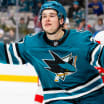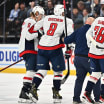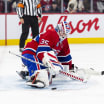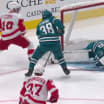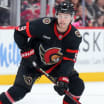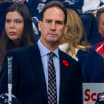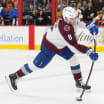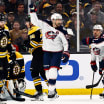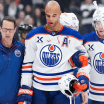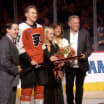Legendary hockey reporter and analyst Stan Fischler writes a weekly scrapbook for NHL.com. Fischler, known as "The Hockey Maven," shares his knowledge, humor and insight with readers each Wednesday.
This week, Stan looks at one of the early formats used for the NHL All-Star Game.
1951 NHL All-Star Game used novel format
First Team vs. Second Team matchup produced spirited play but didn't catch on with fans
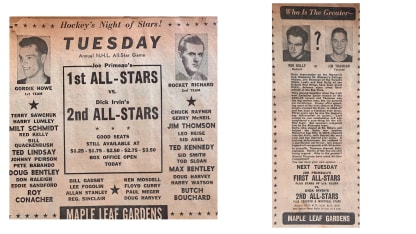
By
Stan Fischler
Special to NHL.com
When the puck drops at the 2020 Honda NHL All-Star Game at Enterprise Center in St. Louis on Saturday (8 p.m. ET; NBC, SN, CBC, TVAS), it will be a far cry from the event held at Maple Leaf Gardens in Toronto on Oct. 9, 1951.
Some called the 1951 NHL All-Star Game a novelty because it was so different from the first four, each of which had matched the defending Stanley Cup champions against a team comprised of players from the other five League members. But NHL planners decided that the time had come to depart from the traditional and try something new that they hoped would be a fan-grabber.
Al Nickelson, writing in The Globe and Mail, was among many who pointed out that the original system had flaws and needed a fresh approach.
"A hitch to the old system" Nickelson argued, "was that any members of the Cup-winning team who were named as all-stars still had to play with their own club against the stars. Thus, only a partial All-Star team was on display."
With a format endorsed by NHL President Clarence Campbell and the six team owners, the game was given a catchy label, "The Dream Team." It pitted the First-Team All-Stars and Second Team All-Stars from the previous season playing against each other in the preseason game. The First-Team coach was Joe Primeau of the Stanley Cup-champion Toronto Maple Leafs. His lineup was augmented by players from the four United States-based teams -- the Boston Bruins, New York Rangers, Chicago Black Hawks (then two words) and Detroit Red Wings.
Second-Team coach Dick Irvin of the Montreal Canadiens filled out his lineup with skaters from the two Canadian teams, his own and Primeau's Maple Leafs. The players selected to fill out the teams had been chosen by a poll of sportswriters and sportscasters throughout the six NHL cities.
"This promises to be the most notable of all the All-Star Games so far," Nickelson wrote.
There was, however, one oddity to the choices. For the first time, the Vezina Trophy-winning goalie wasn't on either roster. The fact that Irvin picked his own goalie,
Gerry McNeil
, instead of Toronto's
Al Rollins
, raised hackles among local fans and media types. After all, Rollins had been the winning goalie when Toronto defeated Montreal to win the 1951 Stanley Cup.
A further rarity was the fact that this was the first All-Star Game without Maple Leafs goalie
Turk Broda
; in fact, it was the first that did not have a Toronto goalie.
With the game scheduled for Toronto, Maple Leafs promoters ran a week-long "Who Is The Greater?" advertising campaign in the local papers and on radio. Each of the newspaper ads highlighted two of the participating stars in a "Who's Better?" challenge. One such spread pitted left wing
Ted Lindsay
of Detroit against
Sid Smith
of Toronto.
"Who is the greater?" the promotion copy read. "How will Lindsay fare when checkmated by
Rocket Richard
? How will Smith compare with scoring champion
Gordie Howe
? The answers will be forthcoming on October 9th."
Another ad featured Red Wings defenseman
Red Kelly
against Maple Leafs counterpart
Jim Thomson
. A third offered the game's two best right wings, Howe of the Red Wings against Richard of the Canadiens.
It was an enticing scheme to go with reasonable ticket pricing. Seats could be had as cheaply as $1.25; the most expensive seats were priced at $3.50.
As for the game itself, one Toronto critic rated the 2-2 tie as "excellent hockey," with six penalties called and plenty of feistiness on both sides.
"This was no exhibition waltz," Nickelson wrote. "The bad man of the evening was Ted Lindsay. He took two minor penalties; one for cross-checking Rocket Richard and another for slashing
Ted Kennedy
."
Lindsay also set up the game's first goal by Howe, his linemate with Detroit, at 7:59 of the first period. Howe turned out to be the only All-Star from the previous season to score for either team.
Second-Team center
Tod Sloan
of Toronto tied it 1-1 at 2:26 of the second period, but Boston's
Johnny Peirson
put the First Team ahead 2-1 at 16:49. Second-Team member
Ken Mosdell
of Montreal tied the game 2-2 at 9:25 of the third period, and the "Dream Team" game ended without a winner.
Though it was reported that there were some hard feelings during the 60 minutes, no fights broke out -- although there were a couple of skirmishes. Nickelson recalled two: "Rocket Richard] in a warning gesture, tapped Lindsay on the shoulder with his stick after the cross-checking penalty was called. And to almost start another feud, the Rocket rode Howe into the boards near the start of the third period and the two wrestled to the ice."
There was, however, a downer, Everyone felt the absence of defenseman
[Bill Barilko
, who had scored the 1951 Stanley Cup-winning goal for Toronto and had become a hero in Canada. Barilko and a friend, Henry Hudson, had disappeared during the summer after flying to northern Ontario on a fishing trip. A month-long search failed to find the pair or the sea plane that Hudson piloted on the trip. It would be 10 years before their remains were found with the plane.
Some critics were displeased that the game ended in a tie. As for the widespread "Who Is The Greater?" promotion campaign, it didn't generate the kind of hype the League had hoped for; the crowd of 11,469 was well below expectations.
The disappointing attendance indicated that the novelty of First All-Star Team vs. Second All-Star Team was not as marketable as the NHL had hoped. After using the format again in 1952, with the teams playing to a 1-1 tie, the NHL went back to matching the Cup champs against All-Stars. On Oct. 3, 1953, the All-Stars defeated the Canadiens 3-1, and 14,153 fans filled the Forum, proving that there was no need for novelty.
The format stayed the same until 1969, when the League made it an East-West game following the 1967 expansion that doubled the six of the NHL to 12 teams.
